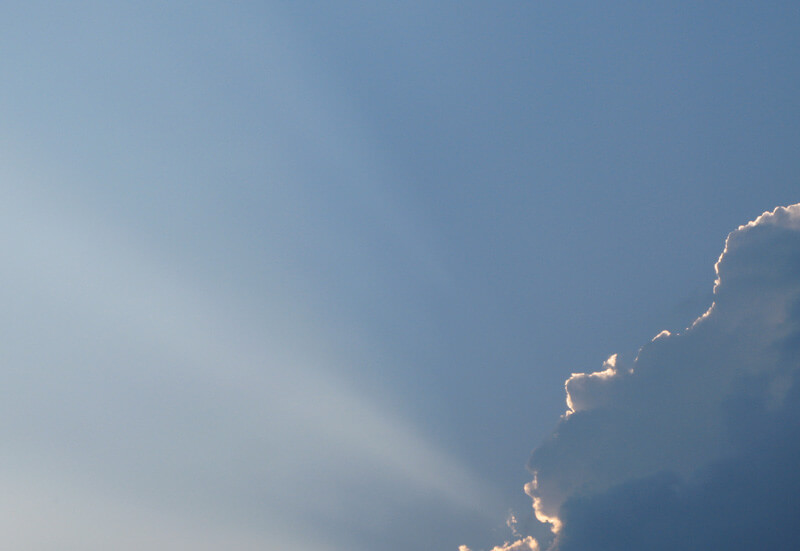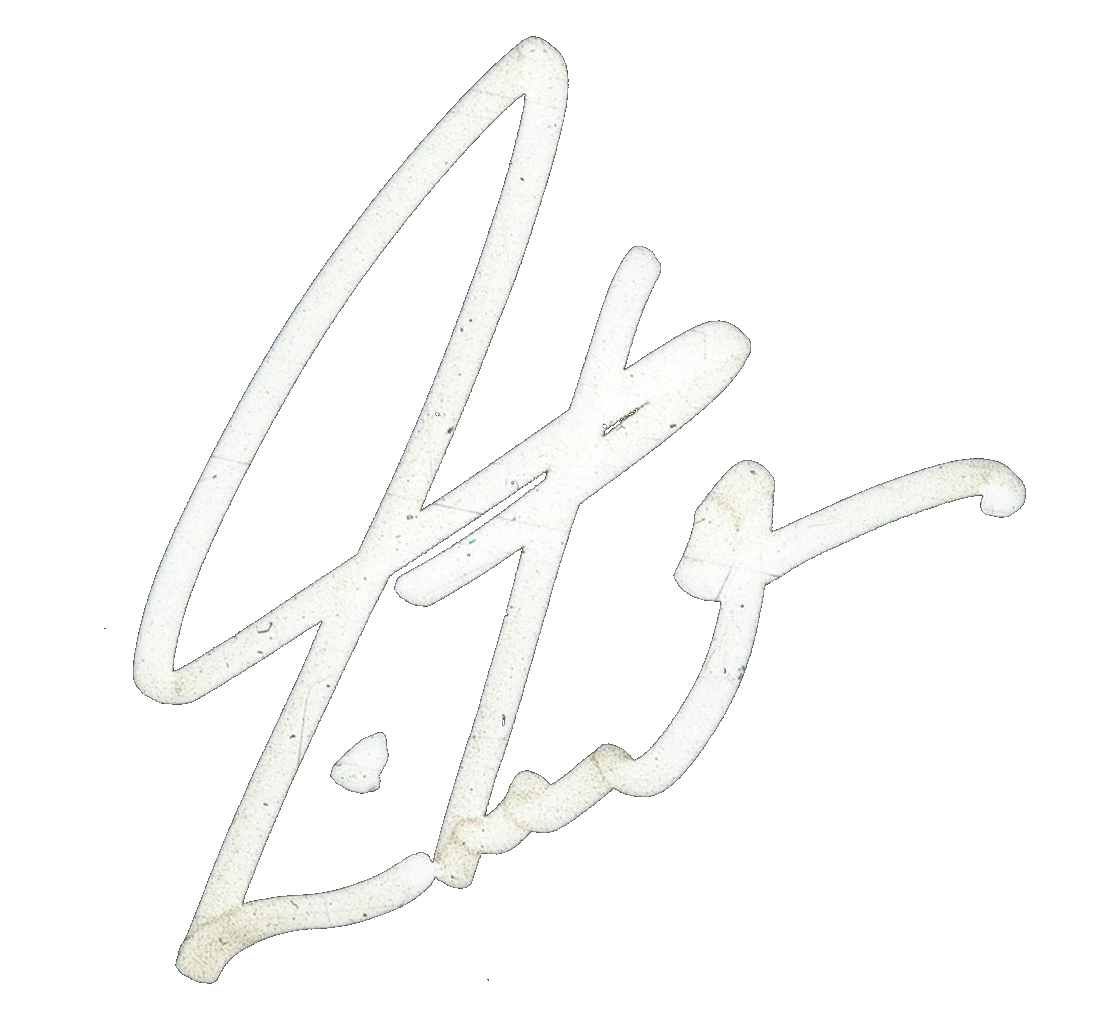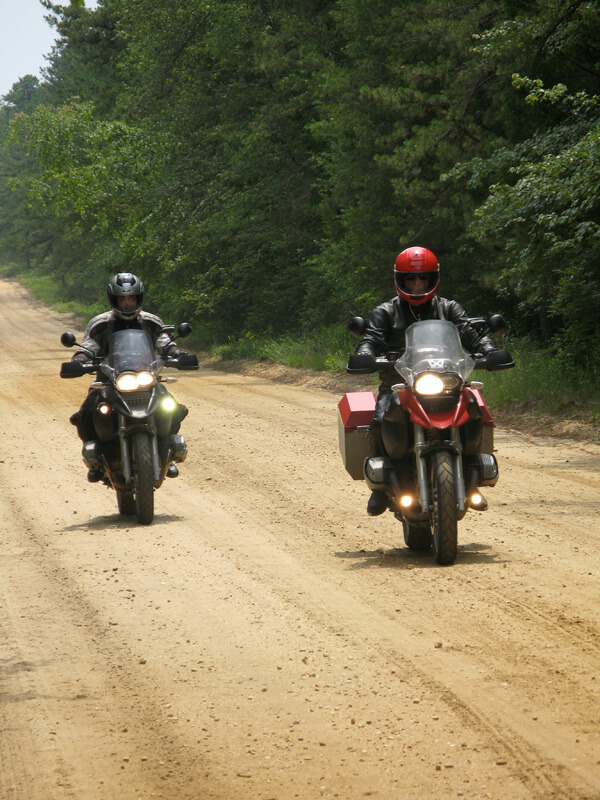
It was Friday, the Fourth of July, Independence Day, and Michael and I were riding to a show in the eastern United States. I can safely wager that few readers would identify the state pictured (no cheating and looking at the band’s itinerary). In Roadshow, I ventured that every state had interesting roads, you just had to look for them, and a prime example I cited was the Garden State—New Jersey.
This dirt and gravel track (sometimes sandy, too—a particular hazard to us on our heavy bikes) framed in pinewoods ran through the Wharton State Forest in the southern part of the state. The area, known as the Pine Barrens, is officially designated the Pinelands National Reserve, a million acres of pitch pines and other vegetation adapted to the sandy, acidic soil and frequent fires. It is one of New Jersey’s more attractive areas, and Michael and I also traveled many pretty little roads in Western Jersey, passing verdant farms, luxurious rural homes, and lush woodlands.
Independence Day was not a holiday for me, but I did exercise a measure of independence in how I got to work—traveling by motorcycle, and seeking out the roads less traveled: shunpiking. Even on a busy holiday weekend, when I design our route to follow roads no one drives unless they live on them, or dirt roads few travel anyway, I can navigate fairly enjoyably through even the most populous states. On this Fourth of July, we were on our way to Atlantic City, yet our road was a million acres away from cities, suburbs, and casinos.
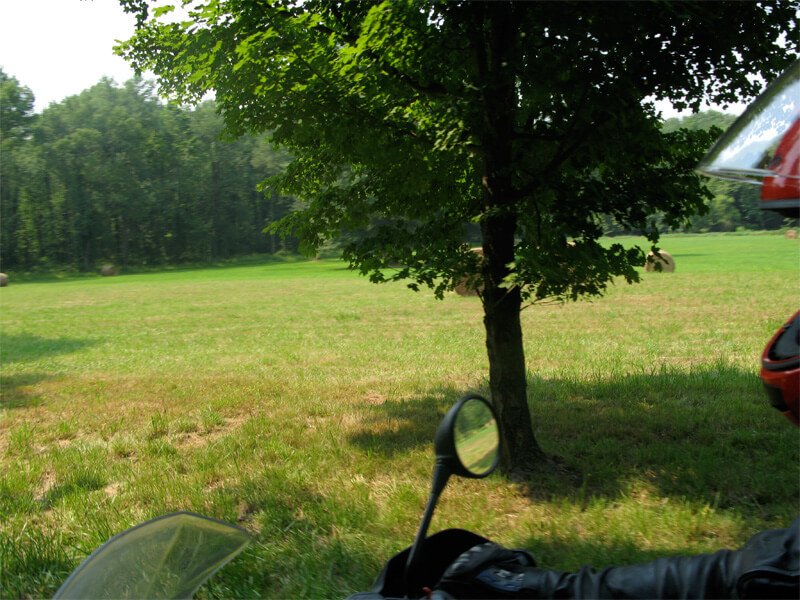
a hayfield and maple tree among horse farms and tree-shaded mansions
The arena in Atlantic City was inside a garish casino, where the management held back (denied us and our fans) the front section of seats. Those were “comped” to the “high rollers” (by definition, big losers), and thus we looked out from the stage at the first few rows (the ones we could see most) filled with people who had no idea why they were there except that it was free.
In contrast to our real fans farther back, who would mortgage their Hemispheres picture discs, and perhaps internal organs, to get closer to the stage, we were confronted by mild curiosity at best, and at worst, rude indifference. As the show went on, we started to see empty seats where bored big losers had slipped away, a woman looking down and texting through whole songs, and a pair of slack-jawed, sulking teens (the Beavis and Butthead of the Guitar Hero generation—as Cartman from “South Park” says in the hilarious sample that Geddy uses in “The Trees,” “Real guitars are for old people”) actually yawning. Anyone would agree that yawning is not appropriate behavior at a rock concert. (Vomiting, yes, but not yawning.)
These casino specimens are only noteworthy because they represent such an utter contrast to the audience around them, and to the front rows every other night—smiling, singing, dancing, and cheering people pressed along the barricade and stretching to the far distance. Several nights this summer, during the opening song, “Limelight” (“Living on a lighted stage, approaches the unreal”—still so true!), especially when we were playing outdoors and I could see everybody, I couldn’t help shaking my head in disbelief at the sheer numbers of people out there. “Unbelievable,” I thought, “All of those people spent their money and their time, on this night in this place, to come and see us.”
That realization is somehow humbling—you feel you have to try to earn that, because it’s obvious that those people deserve the best you can give them.
A couple of years ago my father sent me an anecdote about baseball great Joe DiMaggio, telling how a journalist asked The Yankee Clipper why he went out and played so hard every day. Joltin’ Joe replied, “There is always some kid who may be seeing me for the first or last time, I owe him my best.” Dad added that this attitude reminded him of someone else he knew, which made me feel good.
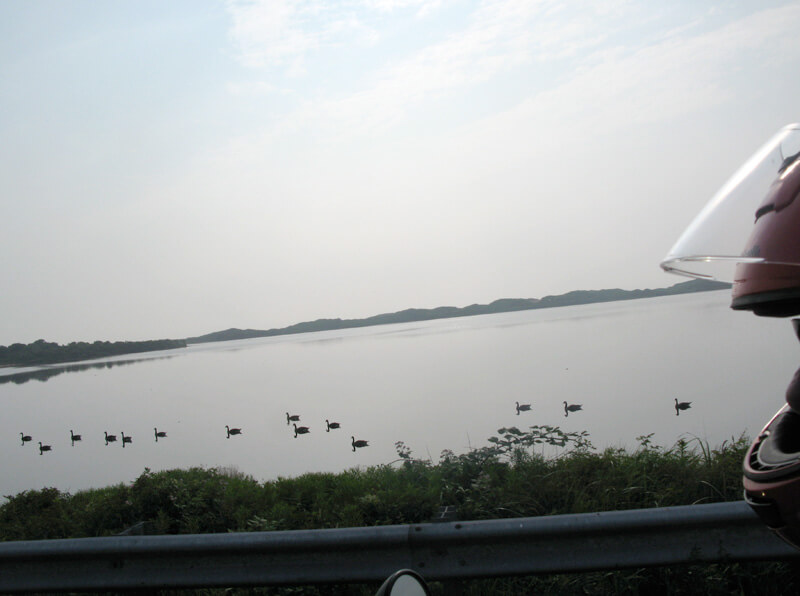
just drifting and reflecting (like the Canadian rider)
All through that Independence Day weekend, Michael and I were motorcycling to shows in the Northeast. I was looking over the maps each day with a combination of apprehension and claustrophobia. Yes, there are good roads to be found everywhere, but the heavily populated East is a challenge. Like lyric writing, designing an enjoyable route is a kind of puzzle—sitting on the floor of the bus’s front lounge in the afternoon before soundcheck with maps strewn about, tracing my orange high-lighter along the gray lines, trying to avoid major roads, larger towns, and suburban sprawl. Then Michael takes on the puzzle of transferring that zigzag scribble to the computer mapping software, “Mother,” and “the boys,” our GPS units, Doofus and Dingus. (I’ve noticed that both Michael and I talk to ourselves while we’re mapping—me while I’m searching out links from one tiny road to another, and Michael while he is trying to translate those tiny roads from the paper map to the computer screen.) In the East, so many lines that look like rural roads on the map (that lying map!) turn out to run through strip malls and subdivisions. In addition, I have ridden nearly all of the “interesting” roads in that area before, plus it was a holiday weekend—no road is fun when it’s jammed with traffic.
So, my glance wandered over the map to the only open area, the blue part, and I had a flash of inspiration: “Go to sea, Billy!” On the morning of July fifth, Michael and I rode down through the pretty, but busy back roads of Connecticut and onto a ferry from Point Judith, Rhode Island, to Block Island, thirteen miles off the coast, in Long Island Sound. (I had long understood that Rhode Island’s name came from a metaphor for an “island of tolerance,” but it actually derives from a mixup between Block Island, first called Rhode Island after its resemblance to the Greek island Rhodes, and the mainland. Block Island was renamed by a Dutch explorer, coincidentally named Block, while Newport’s island was changed from Aquidneck to Rhode Island, which later became the name of the state (one of the Original Thirteen). The only town on Block Island, New Shoreham, with an off-season population of barely 1,000 souls, calls itself “the smallest town in the smallest state.”
Block Island felt like a smaller version of other New England islands, like Nantucket or Martha’s Vineyard, with large old white-painted, shuttered hotels in the Colonial style beside seafood restaurants and souvenir shops along the waterfront, gray-sided saltbox houses tucked among the dunes and salt-resistant foliage, a pair of historic lighthouses, and a few tiny roads through a tumbled green landscape that was fragrant with sea air and flowers.

Here Michael and I have reached the end of the road again (continuing a theme from my previous story, “When the Road Ends,” we were turned back a couple of times this run, in Kentucky and Ohio—once because, as a local advised us, “a crick runs through that road”). We were at the island’s northern tip, with the North Point Lighthouse in the distance. I was pretty sure we could make it all the way across that rocky beach to the lighthouse, but Michael always discourages me from trying stunts like that. Not that Michael is above breaking the law—why, I’ve seen him exceed the posted speed limit, oh, every day—but, given his credentials as a private investigator, and contract work with federal law enforcement agencies, he draws the line at breaking federal laws. Like the time in Puerto Rico when he didn’t want to follow me into a national forest road just because there was a government sign prohibiting anyone but “authorized personnel” beyond that point.
“Well,” I said, “I’m authorized—by me! Let’s go!”
Michael said he considered my argument specious, and my behavior unconscionable. (What he actually said was less articulate, and less quotable.) I said “Hmpf,” tossed my helmet, and turned around.
Block Island proved to be a restful getaway, even just for one night, and after a decent dinner and some spectacular “Fifth of July” fireworks, I opened my hotel room window to the sea air, and had a deeply refreshing, and much needed sleep. (A few days later I smiled at a sign along the New York shore of Lake Ontario for a place called “Point Salubrious,” a Latin name meaning “beneficial to health.”)
In the morning, while Michael and I waited for the ferry back to the mainland, and to a show in Connecticut, we decided to ride a short loop around the southern part of the island. Because it was hot and muggy, and island traffic was light and slow-paced, I followed Michael’s bad example and rode without helmet and jacket—just to see what it was like, really. “Going commando,” we called it.

In a couple hundred thousand miles of motorcycling in the past fourteen years, only twice have I tried riding helmetless—one time around an open stretch of hardpacked sand in the Sahara, for a mile or so, and that morning on Block Island. It was the kind of place where residents and visitors typically rode around on bicycles and scooters, though I read in the local paper that thirty percent of the island’s emergency medical calls were for bicycle and scooter accidents.
As we rode along the island’s narrow lanes at 20 or 30 mph that morning, I was surprised to find I actually didn’t like the feeling at all. Even at such a slow speed, the wind was loud, and buffeted my face and head, so I found the experience of being bare-headed uncomfortable and distracting. I can only imagine what that would feel like on a 400-mile day, or a 1,000-mile day, compared to wearing a full-face helmet. With my own head encased in that light, airy, transparent cocoon, I still feel plenty exposed to the elements—every degree of cold or heat; every waft of fragrance in the air, from blooming flowers to burning brakepads—yet I feel more focused on the road, able to observe, plan, and handle the motorcycle with a sense of composure. (Interesting that I’ve now applied that word as a desirable component of cross-country skiing, drumming, and motorcycling.) On the bike, that calm, yet sharply aware feeling is especially apparent when wearing earplugs, which attenuate the wind noise while still letting in “necessary” sounds—horns, sirens, and shouted conversations with your riding partner at gas pumps (Michael and I notice people staring at us sometimes). In my clear-lensed bubble, I eliminate the sensory overload and ride with a sense of peace.
That experience of riding “naked,” as it were, and a couple of other coincidental experiences around that time that will soon be told, had me thinking about the helmet question. Perhaps surprisingly to non-riders, helmets are a huge issue in motorcycling politics, with many American states having passed helmet laws, then repealed them in deference to “individual rights” lobbyists. It occurs to me that the combination of principles—freedom of choice, personal responsibility, and social responsibility (taking care of those who don’t take care of themselves, which often results in a severe dichotomy of compassion and tyranny), and, yes, a question of simple independence—has resonance to other issues in modern life.
I have no wish to deliver a sermon, but would offer these thoughts as more like . . . a meditation. Something I’ve been thinking about for many miles.
So, meditating as a quasi-libertarian (left-wing conservative, right-wing liberal, what have you), helmet laws are not an issue at all to me, on motorcycles or bicycles; I just wear one. Questions of “individual choice” in your wardrobe do not apply if you are, say, a race-car driver, a jet-fighter pilot, a skydiver, a firefighter, or a fragile human being perched on an unstable two-wheeler in a demolition derby. Such activities are just too hostile to be casual about. When you place yourself in harm’s way, you might as well protect yourself as best you can.

Off-pavement in the Adirondacks
photo by Michael Mosbach
About motorcycling, it has been said that there are two kinds of riders: those who have fallen down, and those who are are going to fall down. I mostly know the first kind, for no one can ride many thousands of miles without some kind of mishap. And it has to be remembered that, as I read once, “a motorcycle is so stupid it can’t even stand up by itself.” I’ve seen several of my riding partners go sliding down the road, then get up and walk away (however gingerly) because they were properly dressed. Most of my own tumbles have been when the bike wasn’t moving—turning around on a gravel road, say, and losing my footing. I’ve fallen a number of times while riding slowly in mud or sand, and had one fairly serious “get-off” in Belize, recounted in Ghost Rider. On a rain-soaked and oily wooden bridge, my tires slipped out from under me and before I knew it the bike was down and it and I were sliding helplessly along the planks, my arm banging into a guardrail. Those few seconds would have been extremely painful for a long time after without an armored leather suit, boots, and helmet—though the tropical heat represented exactly the conditions some riders complain are “too hot” for protective clothing, and when helmets are “uncomfortable.”
Well . . . it’s not hard to conjure images of other conditions in which an unprotected rider might feel hot or uncomfortable. A full-body cast, say.
One Saturday morning in late June, Michael and I were riding a back road through southern Indiana toward Kentucky, and we saw flashing lights ahead of us. Two police cars and an ambulance framed a big chrome-laden motorcycle in the middle of the road, and a rotund deputy raised his hand to stop us. The cruiser-style bike was scratched and dented, and must have been picked up after a fall, while the rider was being attended to on a nearby lawn. We killed our engines and stood astride our bikes, feeling a little dread that we were witnessing a tragedy (a statistic, too, alas). I noticed a long gouge in the asphalt where the bike must have scraped along the road on its side. My best guess was that a car had pulled out of a driveway in front of the rider, he’d grabbed the brakes and locked the wheels, and gone down.
A friend of the victim’s drove up and rode the scarred cruiser off the road, and we watched the gurney being wheeled to the ambulance. The victim’s legs and feet were bare where his jeans and shoes had been cut away, and his head was swathed in white bandages. His friend said he was going to be all right, but, “His face is smashed up pretty good.”
When the ambulance had driven away, the deputy waved us on, and Michael and I started our engines, lowered our faceshields, and rode east toward Kentucky. Witnessing that crash scene would not be a “sobering” experience, a cautionary tale that would urge us to take it easy that day (or any other), because—in a deep distinction—we were not doing what that guy was doing. Anyone can be undone by an unavoidable accident, and suffering is always evil, but how awful to know your fate was the result of a series of thoughtless mistakes.
(Another of my riding mantras, which guides so many of my choices and actions on the motorcycle—my roadcraft: “It mustn’t be my fault.”)
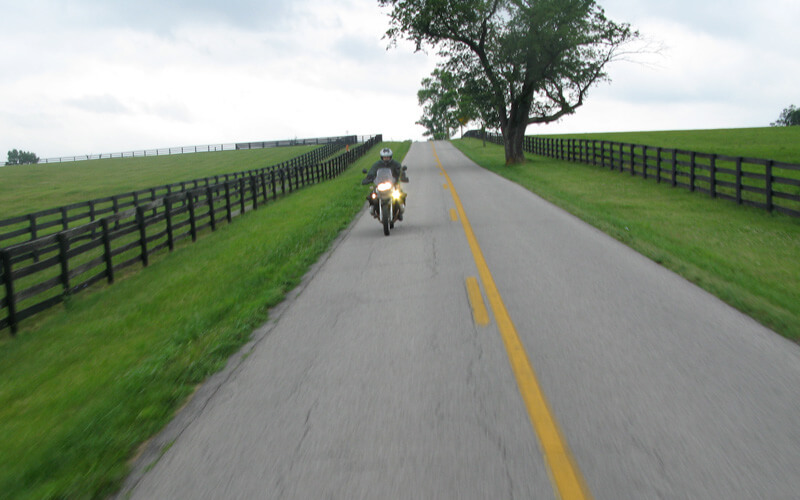
Like many motorcyclists, I resent non-riders harping about the danger, even folly, of motorcycles (or, ha-ha, “murder-cycles”), and the jokes about doctors calling motorcyclists “organ donors.” However, to my shock and horror, that last part is no joke.
Recently I happened to see a story in the New York Times (July 13, 2008) titled “The Pros of Motorcycle Helmets,” in which reporter Jerry Garrett wrote that victims of motorcycle crashes were indeed favored by the medical community as organ donors. He recounted how a motorcyclists’ rights organization had contacted a hospital to enlist their support for a “freedom of choice” coalition—specifically, to support the right of motorcyclists not to wear helmets. The hospital directors were concerned about the ethics (or at least, ramifications) of such an endorsement because, as one doctor stated, “Motorcycle fatalities are not only our number one source of organs, they are the highest quality source of organs, because donors are usually young, healthy people with no other traumatic injuries to the body, except to the head.” The hospital’s “ethical” issue was actually about (surprise) money—the loss of income the hospital would suffer as a result of a reduction in available organs for transplants if motorcyclists wore helmets. They decided to stay out of it.
Granted, the figures on motorcycle fatalities, especially from head injuries, are alarming, but a look at the details shows that those tragedies are so often unnecessary. The majority of such incidents share common causes: the victims were young, inexperienced, drunk, and bare-headed.
One hot Sunday in July, Michael and I were riding to work in a state with no helmet laws, and many other motorcycles were on the road, some with wives, girlfriends, or children as passengers. Michael, being more easy-going about such matters, remarked that he really could understand guys not wanting to wear protective clothing, but—he shook his head—“How could you put your loved one on the back like that?” It’s one thing to risk your own skin, if you think the odds are in your favor, but how would you feel if something happened to your passenger?
But a sermon won’t change anyone’s mind; you can only “preach by example.” I always wear a full-face helmet and an armored suit (I follow the example preached by motorcycle racers, who wear leather, because nothing saves a fallen rider’s skin like the skin of a cow). Years ago Brutus and I were fueling our bikes in sweltering Lake Havasu, Arizona, and a woman said to Brutus, “Aren’t you hot wearing all that?” Without missing a beat, Brutus shot back, “Yeah, but I’ve grown attached to my skin.”
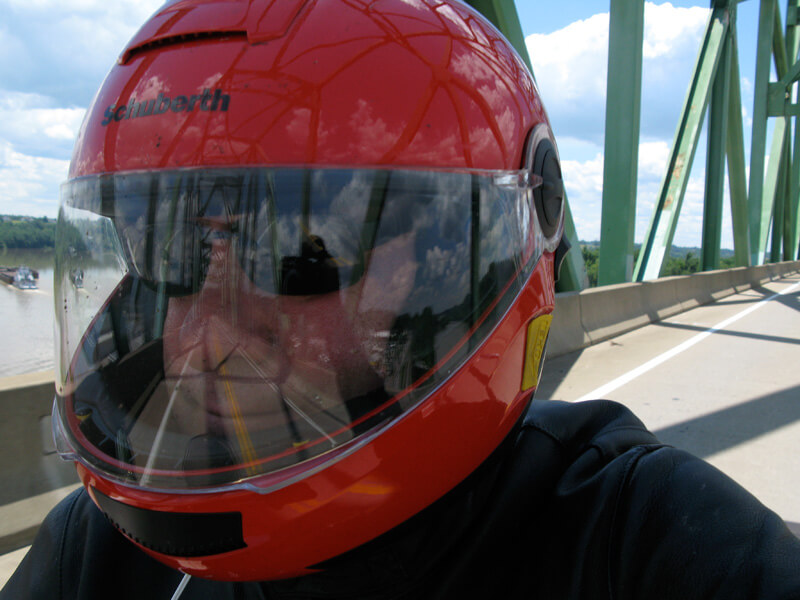
barge-tug in background, the road ahead reflected in my faceshield
If others feel invulnerable, confident in their own skill and concentration, and that of others on the roads around them, then . . . “go with God.” (Or Darwin.) It just makes me wince to see them—if they can’t imagine what might happen, I can. I have said before that such behavior seems like a failure of imagination, and in trying to safeguard my own place on the road, I’m always picturing some terrible thing that could occur, and guarding against it. (I call it the “what if?” game—what if around this curve there’s a tractor or patch of gravel, or what if that car turns left in front of me?)
Early experience was instructive for me—even on a bicycle. I first started carrying a bicycle on our tour bus in the early ’80s, getting it out to ride around on days off and the afternoons of show days. On about the third day of that experiment, I was pedaling through Portland, Oregon, among a crowded afternoon throng of pedestrians and cars. Suddenly, amid all that, I had an epiphany—I was invisible. “These people don’t even see me!” Observing more experienced cyclists around me, I decided that putting a bright white “brain bucket” on top of my head would help, and stopped at a bicycle shop that day to buy one.
That first impulse to put something on my head was about visibility—conspicuity—but further bicycling experience opened my eyes to the protection factor. On one of my first bicycle tours, in the mid-’80s, I was laboring up the Rogers Pass in the Rocky Mountains of British Columbia in pouring rain, and was struck on the head by a fist-sized rock falling from the mountainside above. Without my dorky white helmet, that really would have done damage. Another time, in Greece, a woman in a group I was cycling with hit a bad pothole and went over the bars of her bike (I heard the crash behind me, sounding like a shopping cart being dumped on its side). She landed sprawled on the road, with a badly gashed chin, cuts around her eyes from her glasses, and a deep gouge in her helmet that would have been . . . something much worse. Experiences like that are “exemplary,” to say the least.
On a motorcycle, after so many years and miles on every kind of road from Alaska to Tunisia, my helmet has been struck numberless times, by insects large and small, stones and gravel, snow, sleet, hail, and rain, tree branches, debris thrown up by other vehicles, an outbreak of big June bugs in Georgia—they hurt even through a leather suit—and a good-sized bird just the other day, bouncing off my helmet. Striking a bare head, any of those flying objects would have been uncomfortable, painful, and potentially worse. Consider the impact of a bird hitting your face at highway speed.
So yes, I understand the fine point that helmet-wearing might be a matter of “individual choice.” What I’ll never understand is why it’s a “matter” at all.
But, as our gay friends say, “That’s a whole other Oprah.”

Changing channels, this Action Self-Portrait shows me passing a farm in Vermont and thinking, “I’d like to stop right now, buy that farm, and live there.” I must admit I often entertain such fantasies (and entertain my wife with them—hearing my rhapsodies on the phone about some new part of the country I’ve explored, Carrie will sardonically reply, “Where are we moving to now?”). Thinking back, I remember having similar flights of fancy in the ’80s, on my bicycle, when I’d be riding in the country on a day off, and stop under a tree for a rest and look at a cozy-looking farm for sale. I would think, “I could buy that farm and hide out there—just park my bike in that barn. They’d never find me . . .”
Or even in my earliest days of touring, in the ’70s, I would get fed up with too much “carney life” (like the Gummi Bears theme song, “Bouncing here and there and everywhere”—and never mind how I know that), and would fantasize about running away to the airport, and just going home.
Those were fantasies of independence, of course—in reality, I had a place to go, and a job to do, and I would go there and do it as well as I could, like Joe DiMaggio. Still, I suppose it’s harmless to pretend that someday I might not have a place to go and a job to do.
Speaking of country roadsides, in front of a farm in Southern Ohio I saw a homemade sign posted: “I Do Not Recommend G & R Plumbing.” That seemed to be a polite, and probably fairly effective, form of consumer protest.
And, most important, it was an independent protest. (No lawyers.)
Earlier this summer, in the West and Midwest, when Michael and I rolled into a town at the end of a long day on the road, I had been finding it increasingly difficult to search out motels and restaurants that weren’t part of some grimly identical chain—another question of independence: where have all the independent businesses gone?
Well, the answer is obvious—vox populi, the people have spoken—and they speak loudest with their patronage. (Hello Walmart, goodbye Mom and Pop.) I try to choose towns for our day-off destinations that are small enough to be enjoyable to get to, but big enough to have a few amenities—Hutchison, Kansas, Summersville, West Virginia, Spirit Lake, Iowa, Williamsport, Pennsylvania, and like that. However, in such places it seemed that more and more I had to settle for the blandest of ticky-tacky McMotel chains, those aiming for that ol’ lowest common denominator. Cheap, and worth it. The people have spoken.
(A Broadway musical version of my quest for character over conformity, as expressed in themes of independent motels and restaurants versus chains, might be called Unchained Melody. All-singing, all-dancing visits to American towns—oh yes! Our Town meets Oklahoma! meets In the Heights. I’ll get together with my usual collaborator on such fancies, Matt Scannell. )

no prizes for guessing which one I chose
Late one afternoon in Austin, Minnesota, I diligently searched the town, and my GPS’s database, for any independent lodgings, yet ended up at the ultimate archetypical national chain—Holiday Inn. That night I made a note toward some thoughts on the matter: “I am not the first to bemoan the vanishing of individuality in American towns, but I may be among the last. Folks, it’s all but gone.”
In the Northeast, where more people mean more customers mean more variety of businesses, my quest was more often rewarded, and hope revived. I found many independent establishments still surviving, if not thriving, and it seems that in more seasonable areas, like seacoasts, ski towns, and northern holiday destinations, there are more independents—perhaps because the abbreviated business year scares off the chains.
One such town that absolutely charmed me was Littleton, New Hampshire, even from the road into it, overlooking thick summer foliage with church spires and the town hall’s tower poking up through the trees. Michael and I stayed at a quaint little family motel, “The oldest motel in New Hampshire, 1948”), a short walk from downtown. We dined at a truly fine restaurant, Bailiwick’s, and strolled back to the motel on a classic summer evening. (Later, on the phone, Carrie had another opportunity to say, “We’re moving where?”)
Next morning, I let Michael sleep (his usual breakfast is a Red Bull and a Red Apple) and walked along Main Street, past prosperous-looking stores, to a perfect little diner, delightfully named Topic of the Town. A spare, white-haired lady brought me a menu, then the orange juice and black coffee I requested. While I waited for the morning special, two pancakes and two eggs ($4.99), I set down my book (A Voyage Long and Strange—excellent—watch for a review soon on Bubba’s Book Club) and decided to try to figure out how the self-timer on my camera worked . . .
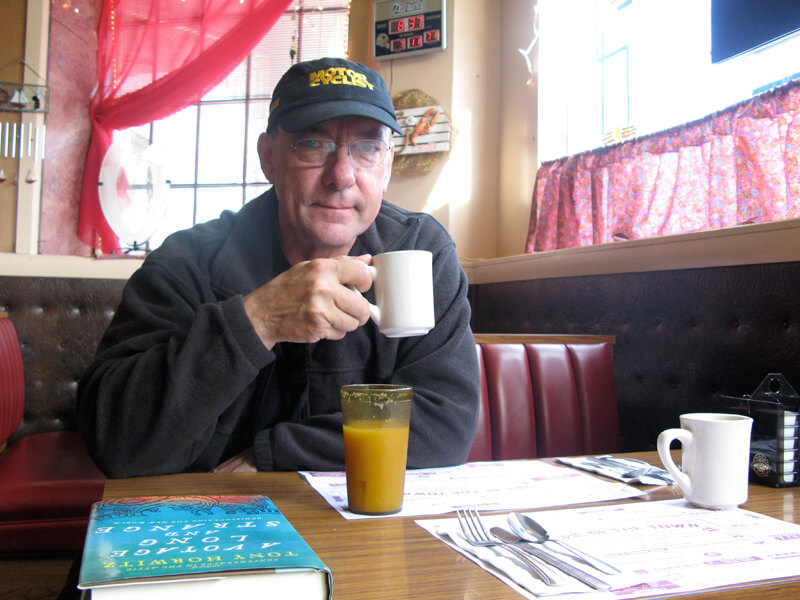
After that idyllic interlude of solitude, nourishment, and peace, I walked back to the motel and woke Michael, and we set out for the road up Mount Washington, the highest mountain in the East, at 6,288 feet. Years ago, in a book of weather trivia I was reading (“That is not pathetic, Michael!”), I learned that the highest winds ever recorded had been measured there—231 mph, in 1934.
At the toll booth, we collected our tickets for the Mount Washington Auto Road (stickers reading, “This Bike Climbed Mt. Washington”), then headed up the narrow, winding, seven-and-half-mile road, nearly all of it paved. Above the treeline, the landscape took on the bare rock and sparse green austerity of the mountains in Wales. The summit wasn’t too windy that day, but it was plenty cool, and the road up and down was certainly dramatic.
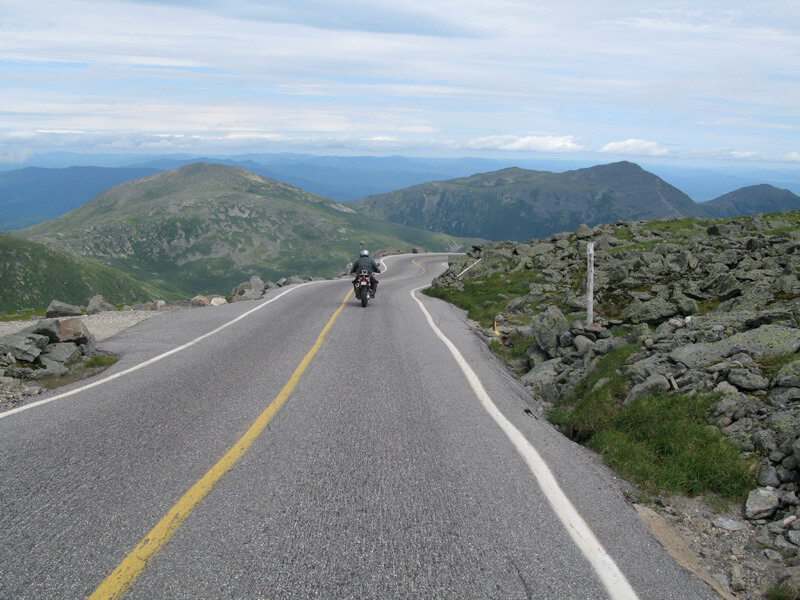
As we get toward the end of a tour, I find I feel a little nervous—not about the shows, but about the rides. “We’ve got this far okay—don’t let anything happen now to spoil it.”
And nothing did, really. In almost 20,000 miles on the bikes this summer, and 24,000 last year, I and my various riding partners had just enough misadventures to be able to say, “Adventures suck when you’re having them,” and to laugh about them later.
The forty-nine shows (added to the sixty-four last year) were exhausting, all right (and some of the rides, too), but satisfying, on the whole. Alex and Geddy and I were talking before the Atlanta show, one of the final ones, and agreed that the overall quality of our performances this summer has been better than ever before—that’s something to be able to share, after all these years. The audiences, as I wrote last summer, were “wonderfully large and unbelievably appreciative (adjectives interchangeable)”, and—crucially—we remained mostly healthy. (Though we all had our sufferings, and toward the end, I lived in a world of hurt. My days began and ended with a couple of Bufferins, which almost rhymes with “sufferings.”)
Michael’s and my motorcycles were also kept healthy by a few more excellent BMW dealers around the U.S. and Canada: Gateway in St. Louis, Bloodworth in Nashville, Cross Country in New Jersey, and BMW of Toronto. Our thanks to them.
And now, as our traveling circus folds up its tents once again after a successful season, crew members, buses, and trucks go their separate ways, and the gear goes back into the warehouse, I still have many notes and Action Self-Portraits that haven’t found their stories yet. But that’s all right—as Ernest Hemingway once advised writers, “Always stop working when you know what’s coming next.”
For now, I look forward to a long, slow recovery, and to a whole series of Independence Days. They will be sweeter for being so hard-won.
